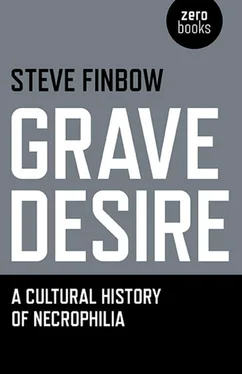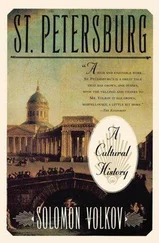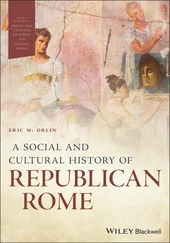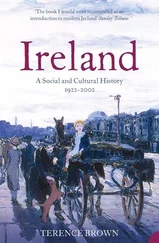These examples of perversion—from sexual deviancy, art, film, and literature—these displacements of bodies and body parts, these fetishizations of objects and human beings stem from two main sources◦– Richard Krafft-Ebing’s 1886 psychiatric study of sexual perversions Psychopathia Sexualis and Surrealist art from the 1930s. Through an obsession with Surrealist objects: Duchamp’s Why Not Sneeze Rose Sélavy (1921), Victor Brauner’s The Wolf Table (1939-47), and Man Ray’s L’Enigme d’Isidore Ducasse (1920), I discovered Jean Benoît’s costumes for Exécution Du Testament Du Marquis De Sade (1959). Even more striking than these dark and monstrous assemblages is an object/costume entitled The Necrophile [dedicated to Sergeant Bertrand] (1964-65). My interest in Surrealism brought me to the works of Sigmund Freud and through Freud to Carl Jung, Wilhelm Reich, and the psycho-sexologist Richard Krafft-Ebing. And, here, in the monumental, if now somewhat outdated collection of sexual case histories that make up Psychopathia Sexualis, I discovered between the stories of the outwardly normal Gruyo (Case 22) and the psychopath Ardisson (Case 24) the story of the man behind Benoît’s necrophile dedication—Sergeant Bertrand. As I read the case history, I wondered what causes a man or woman to want to have sexual congress with a corpse? Is necrophilia the ultimate taboo? Or is it an act of desire perpetrated on an object that is no longer human? To Heideggerize it, where possibility has ended, death resides. With no more actuality, I become a thing—the time of the possibility of impossibility. As in Bataille’s fiction and in Nekromantik, the I becomes an eye, an object, translated into testes, into an œuf, the eye becomes the progenitor of all potential ‘I’s, of the impossibility of possibility, the conjoined mother/father of the event of actuality. ‘it’s an interesting question—in what way is intercourse per vagina more stimulating than with this ashtray, say, or with the angle between two walls? Sex is now a conceptual act, it’s probably only in terms of the perversions that we can make contact with each other at all. Sexual perversions are morally neutral, cut off from any suggestion of psychopathology—in fact, most of the ones I’ve tried are out of date. We need to invent a series of imaginary sexual perversions to keep our feelings alive.’ [17] The Atrocity Exhibition, p. 95.
Haunter of graveyards and morgues, the necrophile embodies our worst fears and our most base desires. In a society in which the image of the corpse is no longer sacred—the huddled bodies of babies twisted like Bellmer dolls on a bloody path in My Lai, the quasi-Ballardian obsession with the remains of Diana, Princess of Wales, Tamil Tiger suicide bombers embracing naked and dead in the back of a truck—the sexual desire for the dead transgresses even the media’s exploitation of human mortality. For the necrophile, as embodied in the character of Sergeant Bertrand, the object of desire—what may be my petite brunette or your American sailor—has been supplanted in fantasy and reality by a motionless body, sometimes intact, sometimes bursting at the fleshy seams with gases and insects. ‘It’s hard to visualize but the day may come when genital sex is a seriously life-threatening health hazard… At that point the imagination may claim the sexual impulse as its own, an inheritance wholly free of any biological entail. As always with such inheritances there will be any number of new friends eager to help in its spending.’ [18] The Atrocity Exhibition, p. 101.
The sublimated purity of so-called normal attraction is superseded, desire is displaced into a simulacrum of the infinite and unknowable other—an ontological seduction, the improbable contradiction of coition between the living and the dead. What drives a man (or woman) to ford a river, climb a wall, risk injury and capture, even his/her own death to dig up a corpse and copulate with it?
From the banks of the Nile, the young slave boy smells the rotting flesh, hears jackals in the hills and fears that the incarnations of Sobek have already found the body. He envisions the crocodiles pulling the woman’s body through the papyrus to the river, the twists and rolls, as they tear apart the corpse’s arms, legs, head, and torso. Yet, the water remains calm and he walks on through the reeds. The stench increases as he comes to a clearing. He sees the body of Ekibé, wife of SutenAnu, stretched out in the midday sun. One more day, and the embalmers can have her corpse. Her body, once beautiful, is now a bloated writhing mess of flesh. No man would desire congress with it. Surely. He lays down his sling and unwraps his skirt, his penis hard and arched as he moves towards the body.
‘Sequence in slow motion: a landscape of highways and embankments, evening light on fading concrete, intercut with images of the young woman’s body. She lay on her back, her wounded face stressed like fractured ice. With almost dream-like calm, the camera explored her bruised mouth, the thighs dressed in the dark lace-work of blood. The quickening geometry of the body, its terraces of pain and sexuality, became a source of intense excitement. Watching from the embankment, Travis found himself thinking of the eager deaths of his childhood.’ [19] The Atrocity Exhibition, p. 112.
Throughout history, myth shrouds the necrophile, allied as s/he is with shady religions, shamanism, vampires, and werewolves. Banished to the margins of the real the necrophile is a ghoul, a seer, a shapeshifter, the embodiment of a human monster, devoid of ethics, an anti-moralist—the epitome of evil. This mythologizing, it can be argued, is a means of distancing ourselves from something we do not understand or fear either as an urge within ourselves or as a danger to community and society. As Slavoz Žižek argues in his defence of M. Night Shyamalan’s The Village, ‘We have two universes: the modern, open ‘risk society’ versus the safety of the old secluded universe of Meaning—but the price of Meaning is a finite, closed space guarded by unnameable monsters. Evil is not simply excluded in this closed utopian space—it is transformed into a mythic threat with which the community establishes a temporary truce and against which it has to maintain a permanent state of emergency.’ [20] Slavoz Žižek, Violence (New York, 2008), p. 20.
The necrophile becomes a mythical monster in order for society to maintain a moral status quo. Necrophilia becomes the ultimate fetish, the last paraphilia, and the weather gauge for society’s moral storms.
Fifteen hundred years ago, in a valley close to the northeastern coast of Peru, near to where in 1534 the Conquistadors would build the city of Trujillo, a Mocha artisan puts aside the vases depicting scenes of anal and oral sex he has made for the priests and the lords. He takes up a thin blade and uses it to roughly incise the leathery clay of the unfired pot. Later, having watched the costumed lords and priests drink the blood of the captive warriors, he pulls the pot from a smoking pit, on the surface, earth-red on cream, is a fine-line drawing of a voluptuous woman her hands encircling an erect penis—the woman is masturbating a skeleton.
‘Sex, of course, remains our continuing preoccupation. As you and I know, the act of intercourse is now always a model for something else. What will follow is the psychopathology of sex, relationships so lunar and abstract that people become mere extensions of the geometries of situations. This will allow the exploration, without any taint of guilt, of every aspect of sexual psychopathology. Travis, for example, has posted a series of new sexual deviations, of a wholly conceptual character, in an attempt to surmount this death of affect.’ [21] The Atrocity Exhibition, p. 120.
Читать дальше












